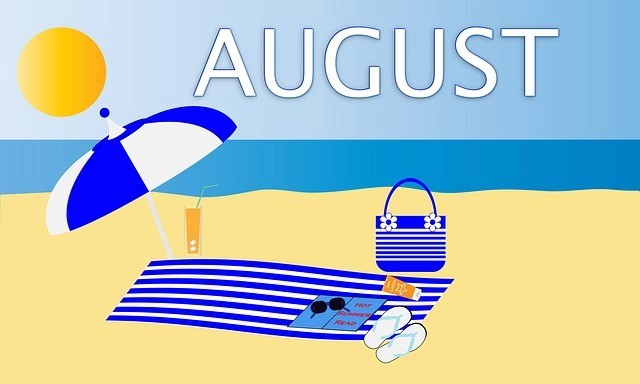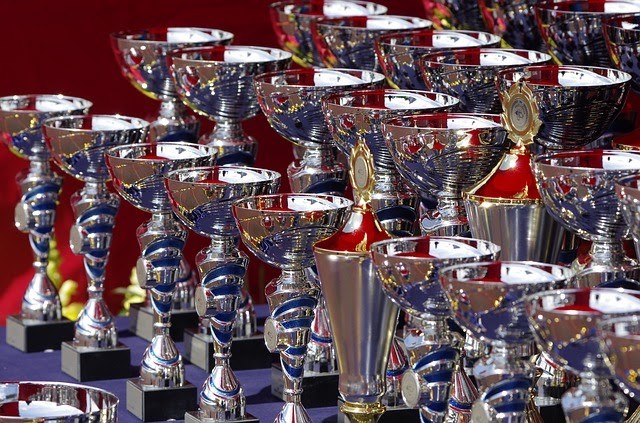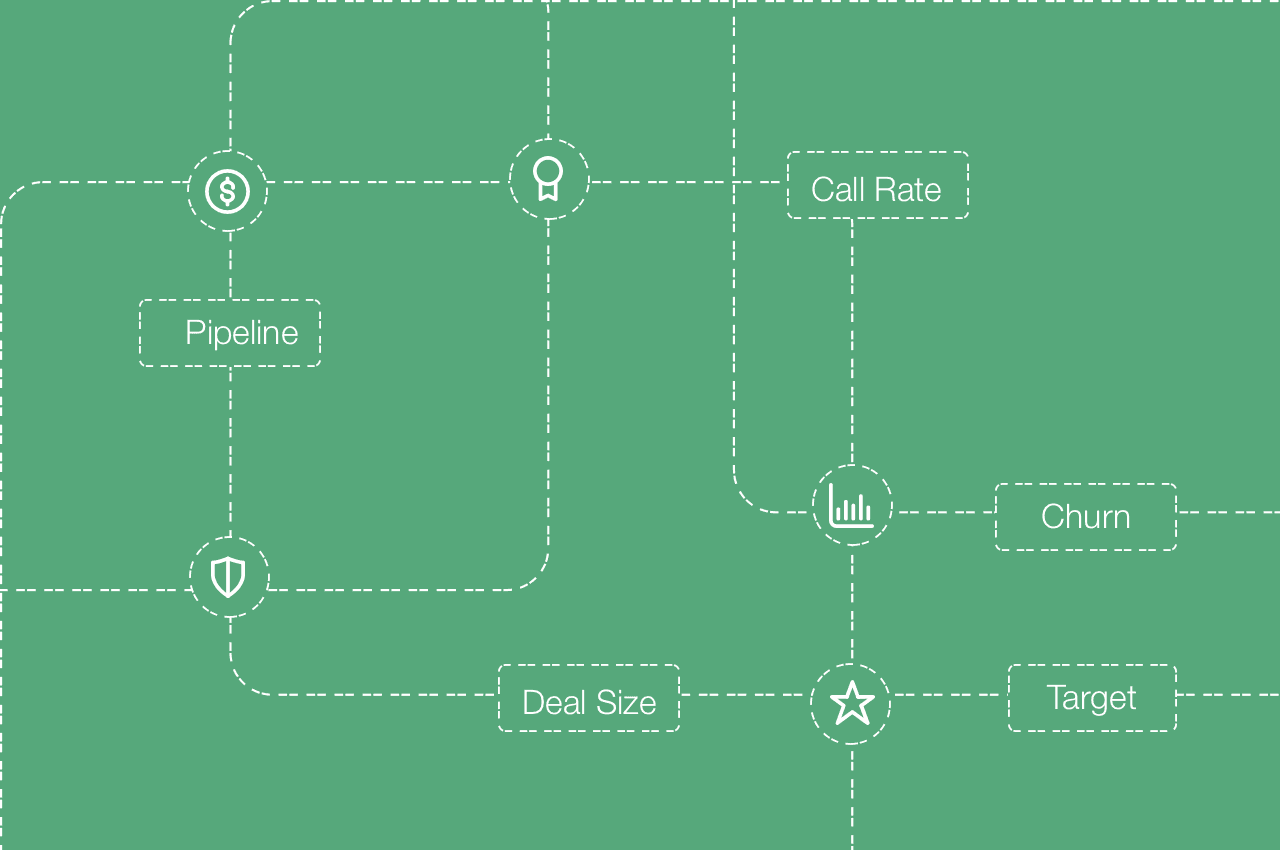Looking for ways to:
Improve productivity in your sales environment?
Keep your reps focused on achieving a specific business goal?
Or amp up sales performance in general?
Employee motivation is the key to achieve all these objectives
The secret to effective sales motivation is to associate key sales activities with a real-world event that already has a lot of buzz around it. Like, the NCCA Basketball Tournament.
Most of you love basketball and follow the march madness. So, it makes for a great idea to build a sales tournament around the march madness theme.
In this blog, we are going to explain a step-by-step procedure of setting up the march madness sales tournament for a larger sales team (>500 sales reps).
Step 1: Define the Goal
A clear-cut, definite goal lays the foundation to build a great contest. As a first step, sit with your team of decision-makers and decide what is it that you want to achieve through this contest.
Your goal must be clearly mentioned in your contest design plan. This makes the agenda clear to everyone, right from the management to the employee.
For our contest here, we want to double up the quarterly revenue.
So we define the goal as: “Increase the revenue 2X by the end of the quarter”
Step 2: Define KPIs
Next, choose the KPIs that you want to measure in the contest. It’s important to choose the right KPIs for your contest. Because these KPIs determine the rules and the ultimate result of your contest.
Here’s what to keep in mind while choosing the contest KPIs:
The KPIs should align with the ultimate business objective/ goal that you intend to achieve through the contest.
The KPIs should be accurately measurable.
The participants should clearly understand through these KPIs, what is it that they will be measured against
Since our objective for this contest is to double up the quarterly revenue, we choose the following KPIS:
Total number of demos given by each team
Total number of quotation sent by each team to the customers
Total amount of revenue generated by each team
Step 3: Create the teams
To create March Madness teams, you need to divide your entire salesforce into different teams. You can do this division on the basis of: * Business units
Departments
Regions or territories
Or any other category that works for you
For this contest, let’s consider a salesforce of about 800 sales reps and see how the division is done.
Divide the 800 sales reps into 16 teams with each team consisting of 50 reps. Make sure that you equally distribute the talent amongst these 16 teams. Meaning there should be an equal distribution of top-performers, middle performers, and bottom performers in all the 16 teams.
Name these teams according to your preference. We give the following names to our 16 teams:
Team Alpha
Team Delta
The Mavericks
Aggressive Achievers
C-Suite Sellers
Dynamite Dealers
Elite Group
Hotshots
The Hawkeye
Power Rangers
Super Sellers
Deal Dragons
Profit Panthers
Quota Crushers
Sons of Strategy
Fast & Furious
For more creative sales team names, check out our blogs:
Step 4: Seed the teams
Seeding is one of the most important steps in the March Madness campaign.
In order to seed the teams, you first need to rank them according to their past performance. While measuring their past performance, make sure that you choose the same KPI that you have chosen for this contest.
For instance, since we have chosen “Revenue” as the KPI here, we need to see what is the total amount of revenue earned by each team in the last quarter.
Ranking: Rank the teams in the following way based on their past performance:
The team that has brought the highest revenue than all the other teams in the last quarter will receive rank-1.
The next team with the highest revenue receives rank-2
Continue this process until all the 16 teams are ranked from 1 through 16
Regions: Next, divide these 16 ranked teams into 4 regions. You can name the regions according to your preference. We are naming them as:
North
South
East
West Each region is comprised of 4 teams
Distribution of talent in the regions: Ensure equal distribution of talent amongst all 4 regions. Here is how to do that:
Take the top 4 best teams from the group of 16 teams. Place each team in each one of the 4 regions. Rank them all as number 1 in their respective regions.
Next, take the next 4 best teams and distribute them in the 4 regions. Rank them all as number 2.
Continue this process until all the 16 teams are successfully placed in 4 regions
Step 5: Matchup teams for the challenge
Now, it’s time to create matchups. Determine which team competes against which one. You need to match up the teams based on their seeding in their respective region.
Note: Usually, in march madness, we get to see the matchups made between a higher-seeded team and a lower-seeded team in a region. But this kind of matchup would be unfair for a sales competition. Because the top-most team would easily defeat the bottom-most team.
To keep the competition fair, pit a team with another team that comes immediately next to it in a region.
Let’s understand how to do a matchup like this in one region. And then the same can be applied for creating matchups in the rest of 3 regions.
So, we have 4 teams in a region, ranked from 1 through 4. Now pit the first team in the region with the second team (Team 1 vs Team 2). Next pit the third team versus the fourth team (Team 3 vs Teams 4). Here is how the matchups are going to look in a region:
Team 1 vs Team 2
Team 3 vs Team 4
Follow this process to create matchups in all the 4 regions
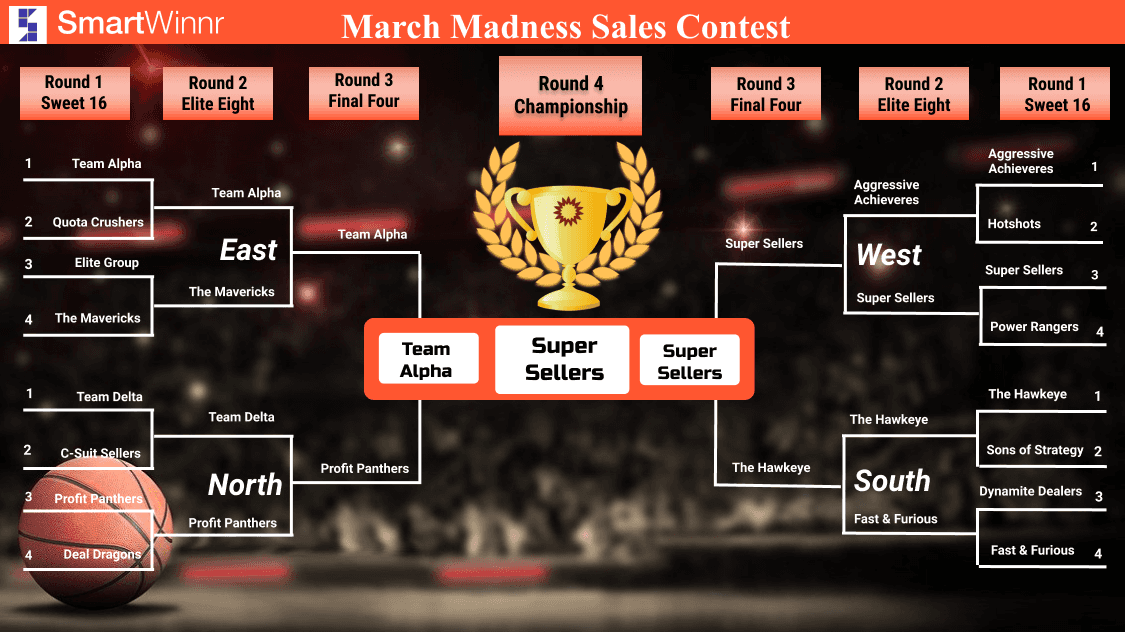
Step 6: Contest Format
Now that your teams are set up for the challenges, it’s time to create a competition around these challenges. Here is a contest format that you can follow:
Number of rounds: 4
Duration: One Quarter (3 months)
Contest Format: This is a single-elimination contest which means that there is going to be the elimination of teams in every round
Rounds
Sweet 16:
In this round, all the 16 teams from all 4 regions participate.
Timeline: Month 1, 1st to 15th
How does this round work? Set a revenue target for each team based on their past performance. For instance, if the total amount of revenue generated by a team in the last quarter is $5000 then set a target of $7000 for them. If another team has made $10000 in the last quarter, then their target should be $14000.
Encourage all the teams to try and reach their respective targets as quickly as they can.
Points:
10 points for each demo
10 points for each quotation sent
20 points for achieving the target
Winners: The teams that achieve their targets before their opponents, win this round and proceed to the next round.
Elite Eight:
After sweet 16, 8 participants will be left to play in this round. These participants compete to reach the final four.
Timeline: Month 1, 16th-30th
How does this round work? Within 15 days, the participants have to win a single largest transaction over their matchups.
Points:
10 points per demo
10 points per quotation sent
50 points for the single largest transaction
Winners: The teams with the largest transaction over their matchups, by the end of 15 days, win this round
Final Four:
This is the round where 4 teams from all 4 regions participate. From here only two of them get to go to the final round.
Timeline: Month 2
How does this round work? In this round, assign the teams with some specific regions/ territories where your sales is lagging and you want to improve. The sales teams need to try to sell and earn as much revenue as they can from these regions.
Points:
10 points per demo
10 points per quotation sent
100 points for earning more amount of revenue than the opponent team
Winner: The teams that succeed in earning more amount of revenue over their matchups, win this round, and go to the final round.
Championship:
This is the final round where the ultimate championship happens between the two finalists.
Timeline: 1 week
How does this round work? Make this round challenging by setting a very high revenue target for the finalists to achieve. The two finalists fight to meet or exceed this target first.
Points:
10 points per demo
10 points per quotation sent
100 points for meeting or exceeding the revenue target first
Winner: The team that outperforms the other team and meets the target first wins the championship.
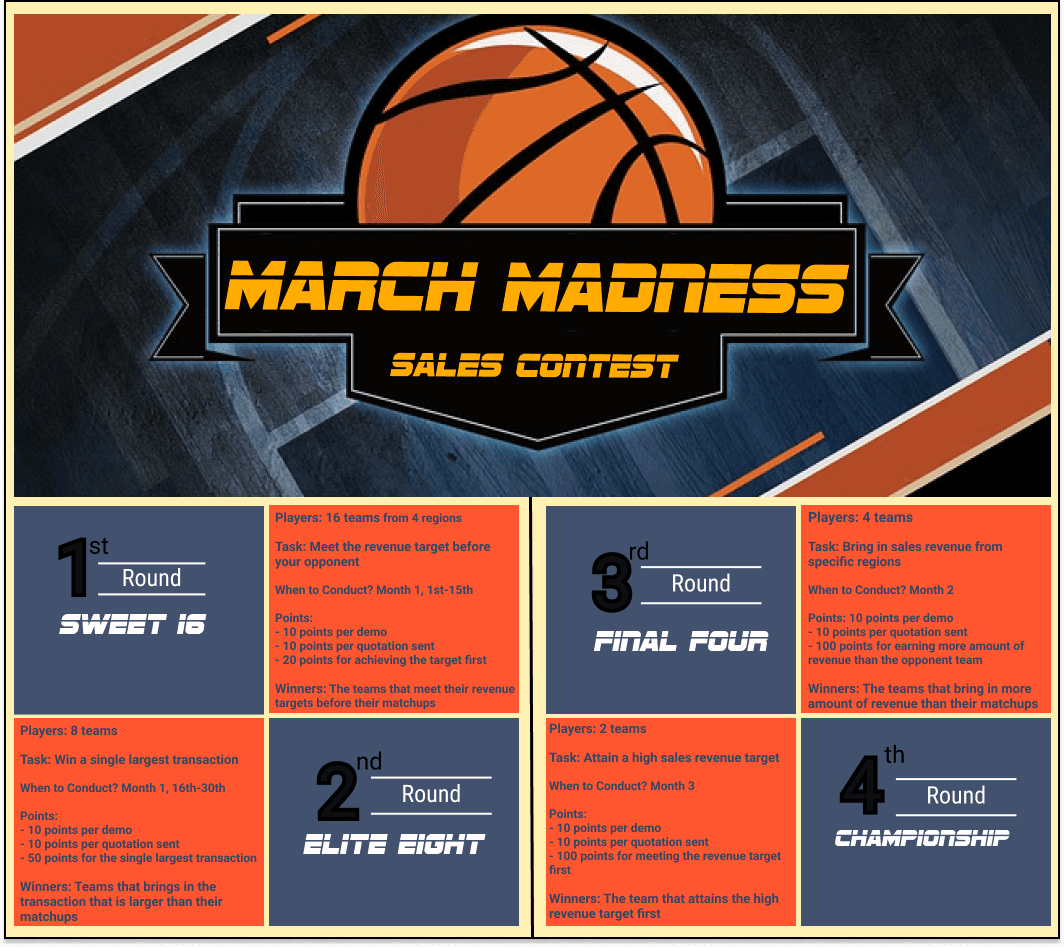
Step 7: Contest Format
Here are some creative awards that you can present to the winners of this march madness contest:
Championship Award: Goes to the team that wins the March Madness Tournament
Runner up: Present this award to the team that has come till the final round in the contest
Star of the Round: This award should be presented after each round. Give this award to the teams who have given more demos or held more meetings or sent more quotations than the other teams in each round. This lets you reward the teams regularly for their hard work instead of making them wait until the end of the tournament.
Buzzer Beater: Give this award to the team that has unexpectedly won over their opponent team in any of the rounds with a minute difference in the achievement
Cinderella: This award goes to the team that has started as a weak performer at the beginning of the tournament but as exponentially improved over the course of the contest
Torch Bearers: Give this award to the team that has proved to be the most inspiring and hardworking team in this contest.
Looking for more such creative employee award and incentive ideas? Get them from our blogs:
23 Sales incentive ideas to keep your sales team motivated
Creative Employee Recognition Award Names
How to Engage the Eliminated Teams?
Run parallel brackets for the teams that get eliminated in the initial rounds. Seed these teams based on their performance and scoring in this contest. Then parallelly organize another march madness contest for them. This ensures that:
All the team get to participate and are engaged in the contest till the end
All the teams get to work productively and contribute towards the business goal
This also helps you to reach your business objective more quickly and efficiently.
Why do you need a sales contest software to run March Madness?
Explore the reasons why you need to adopt a sales contest software to run your contests successfully
Use SmartWinnr for March Madness themed sales contest
Automate the process of running march madness with the help of SmartWinnr’s gamified platform. No tedious excel calculations, real-time leaderboards, mobile app, notifications, and many more.
Interested to learn more about running your march madness contest through SmartWinnr? Book a demo with us today!
Looking for more sales contest themes?
Explore our sales contest designer tool. Get a customized sales contest theme and design that suits your business requirement.
Related Posts
Looking for a sales training software that takes your sales training to a whole new level?
Explore SmartWinnr’s Learning and Gamification features. Learn how to run fun and engaging sales training and sales coaching for your team through SmartWinnr.
Curious to learn more about it? Book a demo today!






































